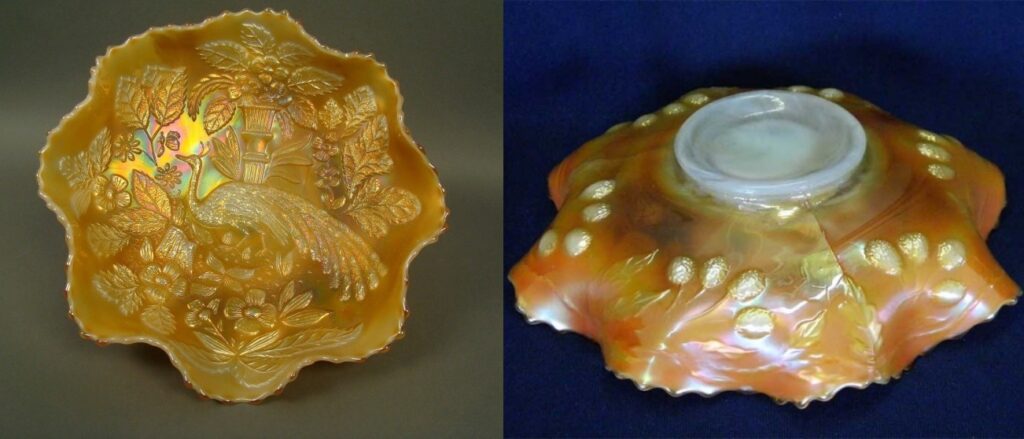Peacock and Urn by Fenton
By Barb Chamberlain
Three different glass companies made a Peacock and Urn pattern. This article is showcasing the Peacock and Urn pieces made by Fenton. If you are looking to find many different shapes in the Fenton pattern, you won’t find a wide variety. Basically, they made just three shapes with variations on the edges. If you enjoy collecting colors in the same pattern, you could have a nice collection.
This pattern, of course, features a peacock by the urn with a small bee waiting to be swallowed by the peacock since it is flying just off the beak of the bird. Fenton’s version of the pattern is easily recognized by the back pattern, Bearded Berry. All bowls and plates should have this pattern to be a Fenton pattern. The compote has no exterior pattern. The bowls and plates also have a sawtooth edge.
Probably the items found most often would be bowls. There are six ruffled, eight ruffled, and ice cream shape bowls that are easily found in many colors. Finding a bowl with a three-in- one edge will present somewhat of a challenge. An aqua deep round bowl recently sold at auction, with two blue nut bowls (some people would call them proof or from the mold bowls) are known. Colors that are harder to find are red, Persian blue, lavender, olive green, vaseline, lime green, aqua, and marigold on moonstone.

On the left you see a moonstone Peacock and Urn eight ruffle bowl. The right photo shows the moonstone base and the Bearded Berry exterior.
Plates are fairly easily found in marigold, blue, and white. While you are out antiquing, if you see a green or amethyst plate at a reasonable price, you might want to purchase it in these two colors. No other colors of plates have sold, so keep hunting, you might find a rare color.

This blue Fenton Peacock and Urn plate, above, speaks for itself.
The other mold shape known in Peacock and Urn is the compote. Most compotes are either flared or ruffled. Unusual colors found in compotes are amber, celeste blue, ice green, olive green, red, and sapphire.

The typical compote shapes are shown above; a lime green flared showing the top, the blue flared showing the compote has no exterior pattern, and the white ruffled compote.
A unique shape made from the compote mold is a goblet. This, of course, was most likely the shape that occurred right from the mold. This unique blue piece is owned by the Bookers. The compotes would have been shaped from this goblet mold.
While we were antiquing a few months ago, we found a marigold “near goblet” in an antique mall. Just the very top of this has been slightly flared. It was enough of a change from the flared compote that I thought we should buy it.
Booker’s blue goblet is shown to the left with a view looking down shown at the top. Our marigold “near goblet” is shown on the right with the view looking down at the bottom.
It’s always good for newcomers in the hobby to study books or carnival glass internet sites to become familiar with what is fairly easily found, and what could be a fun and unusual piece to add to your collection.
If you have any shapes not mentioned or a rare color, please send me photos and information so I can include it in a future edition of The Carnival Pump. Send it to me at 124 E. Honey Creek Drive, Manchester, IA 52057 or email it to dbcham@iowatelecom.net .
Photos courtesy of Carl and Eunice Booker, Seeck Auctions and the editor.
This article first appeared in the ICGA Pump in the June 2020 issue and is reprinted with permission.

